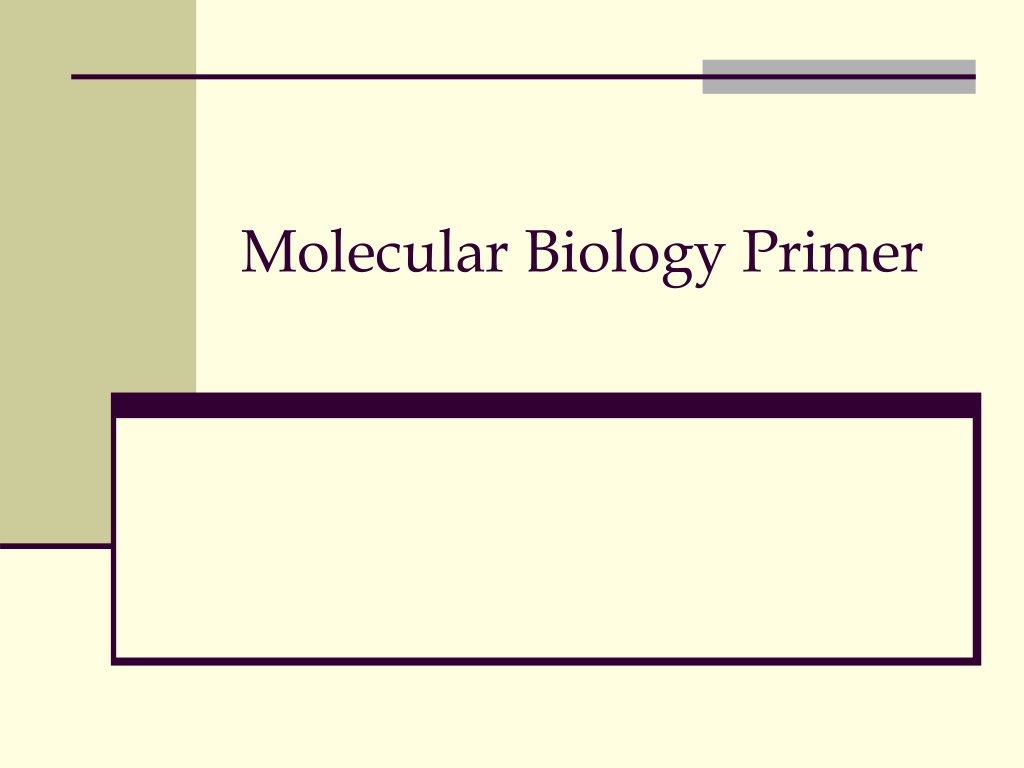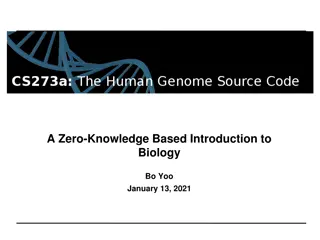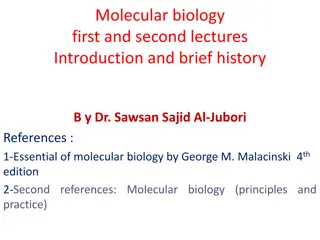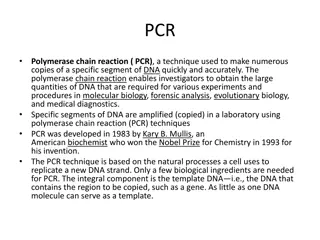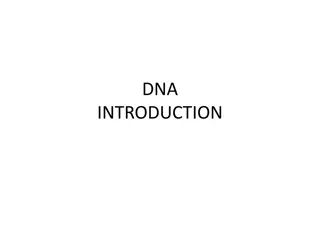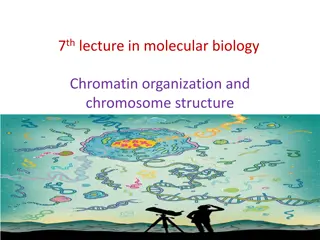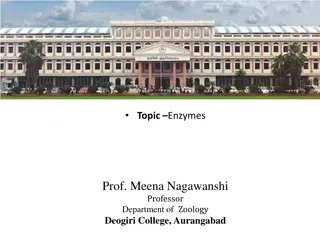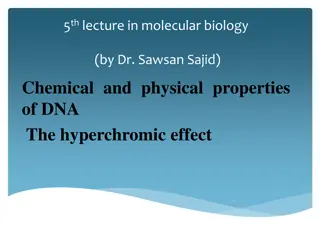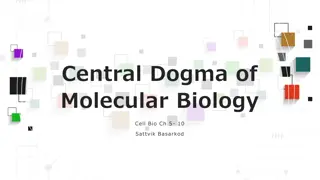Exploring the Evolution of Molecular Biology: From DNA Discovery to Genome Complexity
Uncover the fascinating journey of molecular biology, tracing key milestones from the discovery of DNA to the intricate structure of genes and genomes. Dive into historical breakthroughs, such as understanding the role of genes in producing proteins, the double helix structure of DNA, and the complexity of the human genome. Explore how genes are coded within genomes through exons and introns, and their role in producing RNA transcripts. Follow the evolution of cellular biology and the significance of genes in shaping life as we know it.
Download Presentation

Please find below an Image/Link to download the presentation.
The content on the website is provided AS IS for your information and personal use only. It may not be sold, licensed, or shared on other websites without obtaining consent from the author. Download presentation by click this link. If you encounter any issues during the download, it is possible that the publisher has removed the file from their server.
E N D
Presentation Transcript
Starting 19thcentury Cellular biology: Cell as a fundamental building block 1850s+: ``DNA was discovered by Friedrich Miescher and Richard Altmann Mendel s experiments with garden pea plants Laws of inheritance, ``Alleles , ``genotype vs. ``Phenotype 1909: Wilhelm Johannsen coined the word ``gene Still .. Proteins were thought to be the primary genetic materials but..
What does a gene produce? Gene ?... Protein
DNA: Birth of Molecular Biology (1953) F. Crick J.D.Watson @Cavendish Lab, Cambridge R. Franklin M.H.F.Wilkins @King s College, London
DNA: A Double Helix Nitrogenous Base Phosphate Group A,C,G,TAdenine Double Helix in 3D Cytosine Guanine Thymine 3 Sugar 5 A Complementary Base Pairing Rule: G A T C G C G Reverse Complement: A 3 5 AGCGACTG TCGCTGAC 3 C 5 T Strand#2 G Strand#1 5 3 Each position is a base pair
A little convention for convenience Let us use a straight line from now on to represent a DNA strand (or equivalently, its sequence) Top strand or Watson strand 3 5 3 5 Bottom strand or Crick strand
Genome The collection of all DNA in a cell Every organism has its own genome The human genome: Humans have 23 pairs of chromosomes Each chromosome is one long DNA molecule (hence, also a DNA sequence) The human genome = 23 x 2 DNA sequences = approximately 3 billion base pairs (haploid copy) Fig source: https://www.edinformatics.com/ Genomes are of varied size and complexity Then, what are genes ?
Genes are coding parts of a genome Genes are internally made of exons (coding segments) and introns (non-coding segments) Exon_1 Intron_1 Exon_2 Intron_2 Exon_3 Spliced Variants of RNA transcripts RNA (a) Exon_1 Exon_2 Exon_3 Exon_1 Exon_3 RNA (b) Each gene can code for one or more RNA product (via alternative splicing)
Central Dogma: DNA RNA Protein
The Central Dogma & Biological Data Genomic DNA containing gene segments Transcribed molecules (RNA molecules) Translated products (protein molecules) Protein structures Slide adapted from: http://www.sanbi.ac.za/training-2/undergraduate-training/
Spot the difference! DNA RNA Nitrogenous Base Nitrogenous Base Phosphate Group Phosphate Group A,C,G,TAdenine A,C,G,UAdenine Cytosine Guanine Thymine Cytosine Guanine Uracil 3 Sugar Sugar 5 A A G G C C G G A A C C RNA types: tRNA mRNA rRNA T U Strand#2 G G Strand#1 5 3 Single Stranded Double stranded
Proteins Like a DNA and a RNA molecule is a chain of nucleotides {A,C,G,T/U}, a protein molecule is a ``chain of amino acids (aka, peptide chain) There are 20 amino acids Rotating space filled model of the RNA Polymerase Alpha subunit CTD Next question: How does a gene encode the information to produce a protein molecule?
Genetic Code: Khorana, Holley and Nirenberg, 1968 Combinatorial Logic: 42 < 20 < 43 Hence 3 nucleotides in a codon
Information Flow During Protein Synthesis Gene 5 3 5 DNA e1 e2 e3 e4 e5 3 Transcription One gene can code for many proteins! (alternative splicing in eukaryotes) mRNA e1 e2 e4 Translation + tRNA Protein Folding Rotating space filled model of the RNA Polymerase Alpha subunit CTD Coding (exons) Non-Coding (introns) Stable Structure Nuclear genome
Genetic imperfections Mutations are changes (edits) on the genome Point mutations (single character edits) are referred to as single nucleotide polymorphisms (SNPs) Point mutations can possibly change the protein product
Genetic imperfections If a point mutation is in the coding part of a gene, it is one of the three kinds: Synonymous: doesn t change the amino acid product e.g., a codon changes from CCA CCC both yield Proline (as the amino acid product)
A case of early Stargardt (tunnel vision) Gene: ABCA4 Genetic imperfections Missense: changes the amino acid product using a substituted amino acid Nonsense: truncates the protein product because of a premature stop codon Protein truncates Fig. source: Genomic quirks
A case of heart failure Gene: DSP Genetic imperfections Frameshift errors: happens when the deletion (or insertion) of a nucleotide could result in shifting of the open reading frame (used in transcription) Fig. source: Genomic quirks
Sequencing a genome Sequencing is the process of spelling out the characters (bases) of the genome It is possible to sequence only fragments of DNA. The lengths of the fragments (aka. reads ) vary based on technology: From 100bp ( short reads ) To 20Kbp ( long reads ) The original draft of the human genome (~3 billion bp) was sequenced for billion$ (circa. 2000) You can now sequence your genome in under $1K https://www.genome.gov/
Genomic databases An annotated collection of all publicly available nucleotide and amino acid sequences. Source: NCBI GenBank, EMBL websites https://www.nlm.nih.gov/about/2017CJ.html
NCBI RefSeq database A comprehensive, integrated, non-redundant, well- annotated set of reference sequences including genomic, transcript, and protein. ~600GB of data http://www.ncbi.nlm.nih.gov/refseq/
COVID-19 genome strains COVID-19 Genome: - RNA virus - Approximately 30Kbp genome size - No. strains recorded till date (Jan 21): 4,046 Diversity of the genome (across strains) by nucleotides: Diversity of the genome (across strains) by Amino Acid product: https://nextstrain.org/ncov/global
COVID-19 genome strain evolution https://nextstrain.org/ncov/global
Several Questions Leading Up to Todays Computational Biology and Bioinformatics What are the nucleotides in a DNA molecule? (problem of sequencing) What DNAs make up the genome of a species? (problem of genome sequencing, genome assembly) What are the genes within a genome? (gene identification/discovery) What protein and RNA products does a gene produce? (annotation) What is the native 3D structure of a protein and how does it get there? (protein folding, structure prediction) Similar questions can be asked of RNAs too.
Several Questions . Are there non-protein coding genes? (pseudo-genes) Under what conditions does a gene express itself, and are there genes that are more active than others under experimental conditions? (gene expression analysis, microarrays) Are there a subset of genes that co-operate, and does a gene s activity get affected by others? (gene regulatory networks) How do genes look and behave in closely related species? What distinguishes them? (gene and species evolution) What is the ``TREE OF LIFE ? (phylogenetic tree reconstruction) How does a protein know where to go next within a cellular complex? (localization, signal peptide prediction) AND MANY MORE .
Computational Biology & Bioinformatics: Problem Areas Structure Sequence Discovery Gene structure prediction RNA structure prediction Protein structure prediction Genome Gene Regulatory elements RNA products Proteins DNA Evolutionary Studies Tree of life Speciation Function Gene to protein annotation Gene expression analysis Microarray experiments RNA interference Metabolic networks/pathway Population Genetics Haplotype analysis Nucleotide polymorphism
Computational Biology and Bioinformatics A rapidly evolving field Technology biological and computational Capabilities Concepts Knowledge and Science A plethora of grand challenge questions An Ante-disciplinary Science? An interesting read: ``Antedisciplinary Science, Sean R. Eddy, PLoS Computational Biology, 1(1):e6
Referred Slide Materials, Acknowledgments, and Web Resources ``DNA From the Beginning (http://www.dnaftb.org), Dolan DNA Learning Center, Cold Spring Harbor Laboratory Stanford University, CS 262: Computational Genomics NCBI website Wikipedia J.D. Watson, The Double Helix: A personal account of the discovery of the structure of DNA
